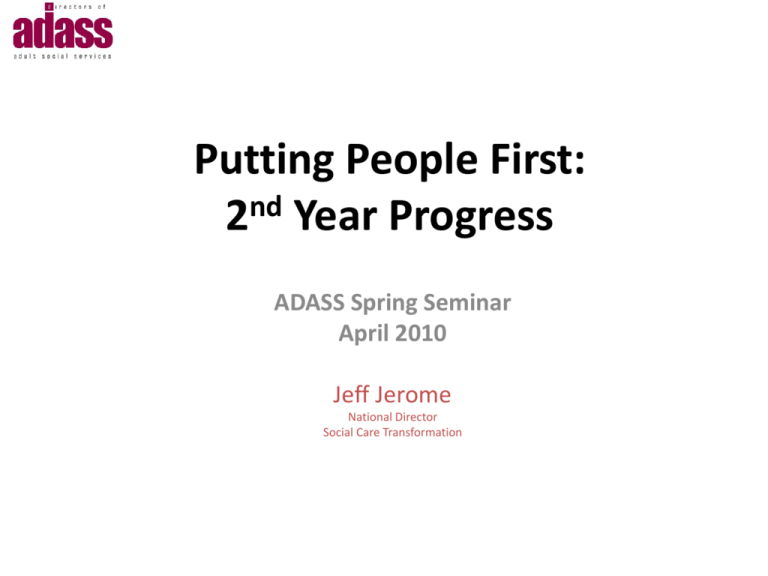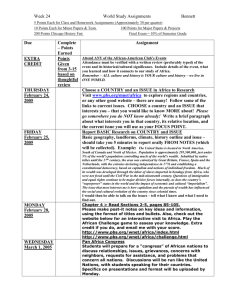Putting People First - Think Local Act Personal
advertisement

Putting People First: 2nd Year Progress ADASS Spring Seminar April 2010 Jeff Jerome National Director Social Care Transformation Overview Drawn from… Milestones Self-Assessment (Oct - Dec 09) : Soft data from 150 councils • PPF Facts and Figures Survey 2010 : Hard data from 149 councils • My observations Headlines (end of 2nd year) • Confident re milestones ( ???) • PPF principles have significant purchase, and ‘story’ better understood • Progress nationally is steady and less uneven, but still worrying group of stragglers re PBs • PB 30% target is challenging re NI130, but achievable re eligible users Headlines - Personal Budgets At end March 2010: • 140,000 PBs - half go to OP (30,000 more if one-offs included) - predicted 205,000 • • • • 1 in 6 of eligible users; half of these get £100+pw £900+m expenditure, £670m via DPs (£680m 2009) 8 in 10 councils give majority of PB spend via DPs 40 commit 20%+ of community budget in PBs Headlines - Personal Budgets • Predicted to rise to 376,000 by March 2011 – 41% of people supported in community but ..…….. • Last year’s predictions optimistic: - predicted 120% increase, delivered 50-80% (205,000) (140 – 170,000) And…. • NI130 30% target would require 500,000 PBs (376,000 is only 22% of NI130) SELF-ASSESSMENT Milestone 1: Effective partnerships (users, carers, citizens) 77% say very, 20% fairly likely to meet March target Support requested: • Assistance with developing ULOs • Sharing good practice examples • Improving communication and awareness National Delivery Plan: • Practice guidance showing how councils are effectively co-producing PPF June 2010 • Practice guidance with focus on co-production of PBs and SDS - Sept 2010 • Comms Strategy ?......... Observation • Milestone not well articulated re ULOs • ‘Story’ still developing 2. SDS and Personal Budgets 63% very, 33% fairly likely to meet 2011 PB target (PB Survey: Only 12 councils predict to have less than 30%; but only 41% of councils have mainstreamed PBs Support requested: • Regional collaboration and learning networks • Sharing best practice • Helping with streamlining processes National Delivery Plan: • Specialist PB support to councils - Ongoing • Finance / IT Systems Principles and Requirements April 2010 • Review of NI 130 • Common RAS learning sets • Finance and I.T work Observations • Most have SDS incorporated in core operating model; numbers will increase faster • Too much time spent on RAS, and too much process • ‘Managed services’ guidance well received 3. Prevention & cost effective services 29% very, 54% fairly likely to meet target by March 69% have a strategy/and or investment programme for prevention and early intervention Support requested: • Regional groups and best practice examples • Help with evidence and benchmarking • Equalising priorities between health and social care National Delivery Plan • ‘Building Community Capacity’ - practice examples and framework for development of local strategies to be published • CSED working on several efficiency initiatives Observations • Re/enablement core, but size variable; often not well joined with NHS • Community dev/outreach approaches (not often alongside reablement) • Telecare sporadic 4. Information and advice • 67% very, 27% fairly likely to achieve milestone • Only 53% have a strategy for universal access to information, support and guidance Support requested: • Best practice and regional groups • Guidance on how to measure success National Delivery Plan • Work ongoing re ‘national spine’ • Further work agreed to identify self-funder position; exploring financial advice • National Care Service expectations (pending) Observations • Community immersion v Call centres; ‘badging’ • Interactive aproaches/I.T. • Enthusiasm from Council leads (needs structural support) Local Commissioning 44% very, 49% fairly likely to achieve milestone by March 87%: good SC transformation/NHS commissioning link; 98% working well with local providers Support Requested: • Regional groups & practice examples of providers having successfully changed • Clarification of relevant legal and procurement regulations. • Clearer guidance on ‘good commissioning’ strategies, practice examples National Delivery Plan • Working together for change: provider development programme • National Market Development Forum • Commissioning Work: Andrew Webster Observations • TCS; IC/reablement; joint investement • Procurement/contracting/dialogue with suppliers • Costs/contributions policy/subsidy/incentives • Understanding community need; JSNA; market position statement • Balance of local investment More on PBs ………. • Personal budget numbers are forecast to rise to 236,500 by September 2010 • … then to over 376,000 by March 2011 • This equates to approximately 27% and 41% of people respectively receiving ongoing community based services Numbers: Proportions of users with PBs • … of OP with services: - 31 LAs have 5% or less - 74 have 10 - 20% (17 had 10%+ last year) - 24 with 20% plus, highest 72% • …of ‘other adults’ with services - 19 LAs have 10% or less - 67 LAs 20% or more, highest 59% (21 last year) • 26 LAs gave info on care home residents who have been allocated PBs: – 18 have allocated less than 100 PBs – 7 between 100 - 500 – 1 over 500. U - 65's : Proportion receiving community services with a PB 70% 60% 50% % 40% 30% 20% 10% 0% Councils Older People: Proportion receiving community services with a PB 70% 60% 50% % 40% 30% 20% 10% 0% Councils % increases in PBs: Actual v Predicted 250% % 200% 150% Actual 10 100% Predicted 50% 0% YH NW GL E EM SE Region NE SW WM PB Numbers : Predicted % PBs March 2011 100% 90% 80% 70% % 60% 50% 40% 30% 30% target 20% 10% 0% Councils PB Spend • As proportion of total social care gross budget: - 88 LAs commit 5% or less via PBs - 15 LAs 10% or more, the highest at 37% • As proportion of community services gross budget: - 48 LAs commit 10% or less via PBs - 42 LAs commit 20% or more, highest 79% (20 last year) • Of money allocated in PBs: 74% are DPs; 26% are ‘managed’ accounts - 17% of the ‘managed budgets’ are via third parties • 52% of all PB recipients had £5k or above p yr (just less than half last yr) % (of PB) spend on DPs 90 80 70 % 60 50 40 30 20 10 0 EM NE SW GL SE Regions NW YH WM E % PBs : Proportions of users & of spend 30 25 20 15 10 5 0 E NW EM GL SE NE WM YH Regions Proportion of Com spend Proportion with PBs SW PB Spend 2009 & 2010 (by Region) 2009 2010 £200,000,000 £180,000,000 £160,000,000 £140,000,000 Spend £120,000,000 £100,000,000 £80,000,000 £60,000,000 £40,000,000 £20,000,000 £0 North West London South East East of England West Midlands Yorkshire and Humberside Region South West East Midlands North East (TOP) 4 Comparisons Council A Council B Council C Council D Proportion of eligible users with PBs 57% 57% 49% 47% Proportion of Social Care Budget 37% 11% 16% 25% Proportion of Community Services Budget 79% 61% 56% 50% DPs as proportion of PB spend 13% 17% 51% 36% Issues Arising • • • • • • • • N1 130 PB improvement work; RAS; I.T. Market Shaping/development Budget management/balance of investment Wider thinking (whole community, transformation) Workforce design; culture CQC, performance assessment Keeping PPF at forefront in the financial climate Reminder of some key goals…… • Getting the money to individuals • Ensuring everyone helped to identify need and potential solutions • Ensuring better choice, control, experience through broadening market offer (inc Q.A) • Helping people be as active and independent as poss • Making best overall use of resource (inc workforce) • Helping people to stay safe END Annual value of PBs Annual value under £1000 16% Annual value over £5000 51% Annual value £1000-5000 33%




